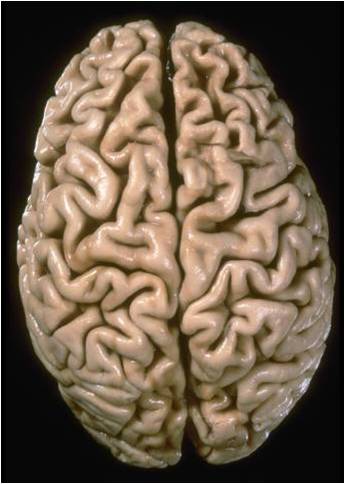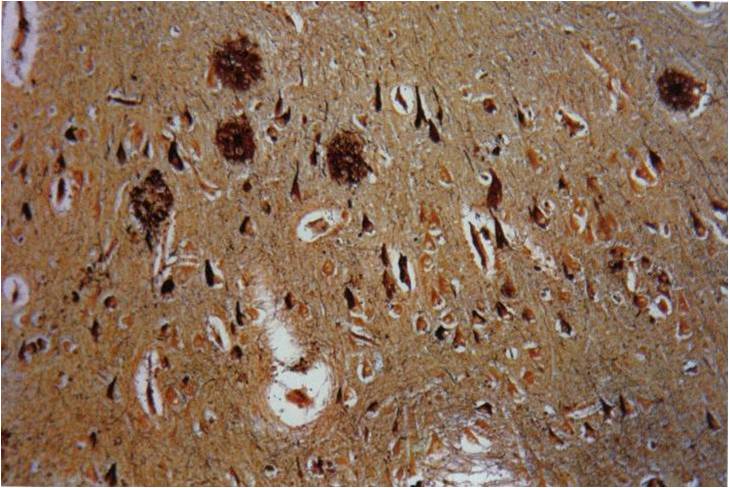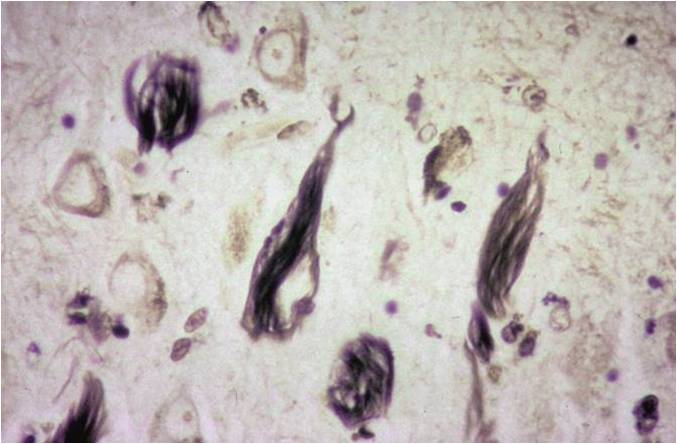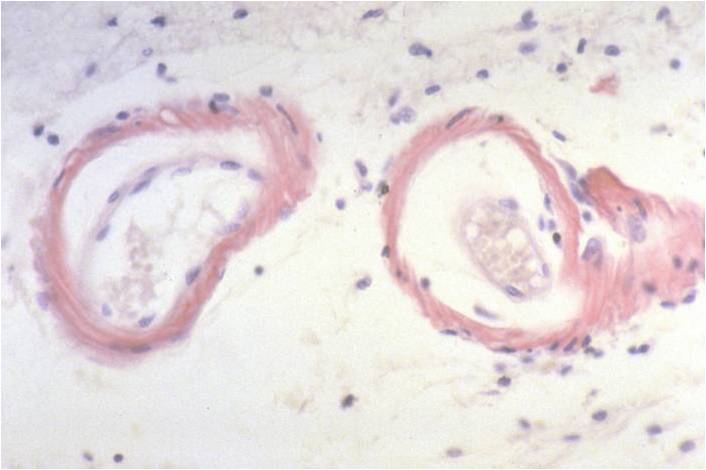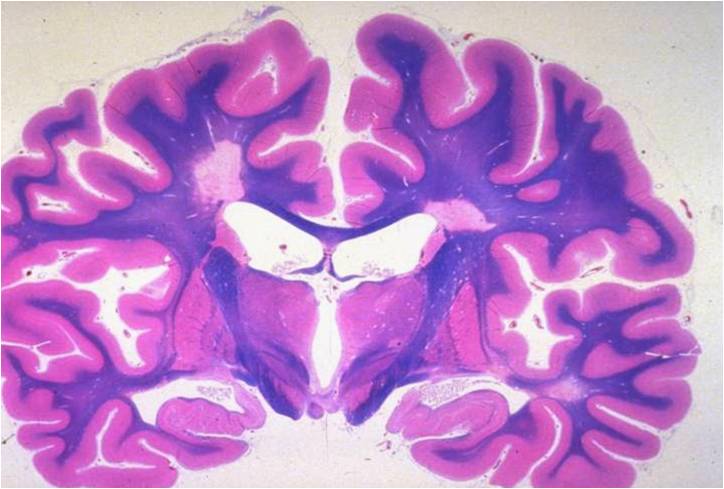Pathophysiology CNS CNS
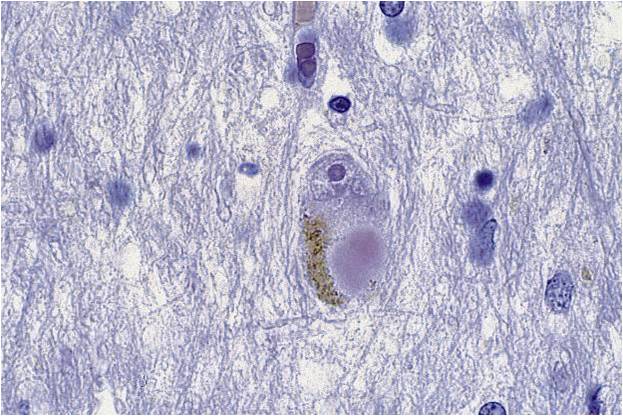
Quiz on first 50 slides of CNS pathophysiology
- 1.
Leptomeningitis is an inflammatory process that is localized to the interfacing surfaces of the _______ and the _________, where ______ flows.
- A.
Dura, Pia, CSF
- B.
Arachnoid, Pia, Blood
- C.
Pia, Arachnoid, CSF
- D.
Dura, Arachnoid, CSF
Correct Answer
C. Pia, Arachnoid, CSF -
- 2.
Which of the following is TRUE about Pachymeningitis?
- A.
Inflammation of the Pia
- B.
Usually a consequence of traumatic brain injury.
- C.
The arachnoid acts as a barrier to infection.
- D.
The inflammation is restricted to the outer surface of the brain.
Correct Answer
D. The inflammation is restricted to the outer surface of the brain.Explanation
Pachymeningitis is inflammatino of the dura usually a consequence of contiguous infection such as chronic sinusitis or mastoiditis. The dura is a barrier to infection therefore inflammation is restricted to the outer surface.Rate this question:
-
- 3.
True or False: The vast majority of meningitis cases are caused by suppurative bacteria and the organsim relates to the sex of the patient.
- A.
True
- B.
False
Correct Answer
B. FalseExplanation
The vast majority of meningitis cases are caused by suppurative bacteria and the organism relates to the age of the patient.Rate this question:
-
- 4.
Which of the following is not true of Bacterial Meningitis organisms and age?
- A.
E. Coli and Group B strep are most commonly found in neonates with bacterial meningitis
- B.
Group A strep and H. Pylori are most commonly found in adolescents with bacterial meningitis.
- C.
H. influenza is usually fuond in infants 3 months-3 years old with bacterial meningitis.
- D.
Strep pneumococcus is usually found in adults with bacterial meningitis.
- E.
N. meningitidis is usually found in military barracks when bacterial meningitis is going around.
Correct Answer
B. Group A strep and H. Pylori are most commonly found in adolescents with bacterial meningitis. -
- 5.
What is the most difinitive diagnostic index of meningitis?
- A.
PMN's in the CSF
- B.
PMN's in the blood
- C.
RBC's in the CSF
- D.
Purulent discharge in the ears
- E.
Elevated white count
Correct Answer
A. PMN's in the CSF -
- 6.
________ are the hallmark of meningitis caused by tuberculosis, viral meningitides, and chronic fungal infections (cryptococcal meningitis).
- A.
Macrophages
- B.
Lymphocytes
- C.
Eosinohpils
- D.
Monocytes
Correct Answer
B. LympHocytes -
- 7.
Grossly, the brain discloses an exudate of PMN's and fibrin which opacifies the _________, and giving a _______or _________ white appearance, usually over the convexities as well as the base of the brain.
- A.
Pia, creamy or white
- B.
Arachnoid, yellow or purulent
- C.
Arachnoid, creamy or white
- D.
Dura, Yellow or purulent
- E.
Arachnoid, grey or cloudy
Correct Answer
C. Arachnoid, creamy or white -
- 8.
True or False: H. influenza elicits a dense leukocytic exudate, which is rich in fibrin over the convexities and therefore creates a barrier to antibiotics.
- A.
True
- B.
False
Correct Answer
A. True -
- 9.
True or false: Because the pia is so delicate, it is an ineffective barrier against the spread of infection and typically does not prevent spread to the underlying brain.
- A.
True
- B.
False
Correct Answer
B. FalseExplanation
The pia, although delicate, is an effective barrier against the spread of infection and generally prevents involvement of the underlying brain.Rate this question:
-
- 10.
Which of the following is not a clinical manifestation of Bacterial Meningitis?
- A.
Head ache
- B.
Convulsions in adults
- C.
Fever
- D.
If untreated, coma and death
- E.
Vomiting
Correct Answer
B. Convulsions in adultsExplanation
Bacterial meningitis frequently causes convulsions in children.Rate this question:
-
- 11.
The classic signs of meningeal infection include all of the following EXCEPT:
- A.
Cervical rigidity
- B.
Kernig sign
- C.
Head retraction
- D.
Murphy's sign
- E.
Brudzinski sign
Correct Answer
D. MurpHy's sign -
- 12.
Which diseased is defined as a neurologic disorder characterized pathologically by the loss of neurons in the Substantia Nigra and clinically by tremors at rest, muscular rigidity, expressionless face, and emotional lability.
- A.
Bacterial Meningitis
- B.
Alzheimers Disease
- C.
Viral Meningitis
- D.
Multiple Sclerosis
- E.
Parkinsons Disease
Correct Answer
E. Parkinsons Disease -
- 13.
Which of the following is NOT true of Parkinson's disease?
- A.
Most commonly occurs in white males
- B.
Typically effects those in the 6th-8th decade of their life.
- C.
Genetic factors do not play a role (except for a rare autosomal dominant disorder)
- D.
The vast majority of cases are idiopathic.
- E.
The disease has been recorded after viral encephalitis and after the intake of a toxic chemical (MPTP).
Correct Answer
A. Most commonly occurs in white malesExplanation
No sex or ratial differences are apparent in Parkinsons disease.Rate this question:
-
- 14.
It has been suggested that Parkinsons disease is an acceleration of normal age related changes.The changes being referred to primarily have to do with the ___________ _______ which relays information to the _______ ________ through _________ synapses.
- A.
Brain stem, sympathetic chain, adrenergic
- B.
Cerebral cortex, cranial nerves, muscarinic
- C.
Substantia Nigra, basal ganglia, dopaminergic
- D.
Prefrontal cortex, afferent neurons, cholinergic
- E.
Medulla oblongota, efferent neurons, achetylcholinestergic
Correct Answer
C. Substantia Nigra, basal ganglia, dopaminergic -
- 15.
What type of infection resulting in injury (gross loss of pigmentation) to the substantia nigra occured during the infuenza pandemic of 1916-1920 which lead to the clinical expression of "postencephalitic parkinsonism."
- A.
Bacterial meningitis
- B.
Acute hepatitis
- C.
Cholelithiasis
- D.
Sinusitis
- E.
Von Economo Encephalitis
Correct Answer
E. Von Economo EncepHalitis -
- 16.
Microscopically, what are the changes seen in Parkinson's disease?
- A.
Loss of pigmentation in the substantia nigra
- B.
Residual atrophic nerve cells are seen known as "Hewey Bodies"
- C.
Pigmented neurons are scarce with small extracellular deposits of melanin, from necrotic neurons.
- D.
Loss of pigmentation in the Locus Ceruleus
Correct Answer
C. Pigmented neurons are scarce with small extracellular deposits of melanin, from necrotic neurons.Explanation
A and D are gross changes seen in Parkinsons. B is also wrong because the atrophic nerve cells are known as Lewy bodies.Rate this question:
-
- 17.
The picture displays an atrophic nerve cells which contain what?
- A.
Rod-shaped, smooth, basophilic mitochondrial inclusions.
- B.
Spherical, granular, eosinophilic cytoplasmic inclusions.
- C.
Square, gritty, lymphocytic periplasmic inclusions.
- D.
Triangular, soft, macrolytic endoplasmic inclusions.
Correct Answer
B. SpHerical, granular, eosinopHilic cytoplasmic inclusions.Explanation
The picture shows residual atrophic nerve cells containing spherical, granular, eosinophilic cytoplasmic inclusions called Lewy Bodies.Rate this question:
-
- 18.
An 82 year old male patient comes in to see you with a mask-like face and is slighty drooling. The paitent presents with slow voluntary movements and a muscular rigidity throughout the entire range of motion with each movement. He has "pill-rolling" of the distal extremities that is present only at rest but goes away each time he voluntarily moves. What is at the top of your differentials?
- A.
Alzheimers Disease
- B.
Multiple Sclerosis
- C.
Stroke
- D.
Parkinson's Disease
- E.
Myesthenia Gravis
Correct Answer
D. Parkinson's Disease -
- 19.
All of the following are clinical manifestations of Parkinson's disease EXCEPT:
- A.
Depression
- B.
Hypertonia
- C.
Hypotonia
- D.
Dimentia
- E.
Akinesia
Correct Answer
C. Hypotonia -
- 20.
True or false: In early parkinsonism, Levadopa is beneficial, however this therapy does not rectify the underlying disorder, and several years later, becomes ineffective.
- A.
True
- B.
False
Correct Answer
A. True -
- 21.
Other causes of Parkinson-like symptoms include all of the following EXCEPT:
- A.
Spider bites (black widow, tunnel spider)
- B.
Drugs (Phenothiazines, Haldol)
- C.
Poison (Carbon monoxide, Manganese)
- D.
Hydrocephalus
- E.
Tumors (Near the basal ganglia)
Correct Answer
A. Spider bites (black widow, tunnel spider)Explanation
Also included in the list are Bilateral infarcts of basal ganglia and cerebral trauma.Rate this question:
-
- 22.
This disease is known as an insidious and progressive neurologic disorder characterized by a loss of memory, cognitive impairment, and eventual dementia?
- A.
Parkinson's disease
- B.
Age-related psychosis
- C.
Alzheimers Disease
- D.
Multiple Sclerosis
- E.
Acute Hemorrhagic Meningitis
Correct Answer
C. Alzheimers Disease -
- 23.
True or False: Alzheimers Disease is restricted to patients younger than 65 years of age and already diagnosed with presenile dimentia.
- A.
True
- B.
False
Correct Answer
B. FalseExplanation
Today, the term Alzheimers disease is used generically for all ages and identifies a specific morphological corollary of dementia.Rate this question:
-
- 24.
Which of the following is a feature of Alzheimers Disease?
- A.
Advances of our pathologic understanding of AD relate to alpha-protein amyloid deposition in senile plaques.
- B.
Plaques located in the spinal cord are linked to intelectual funciton and are a constant feature of AD
- C.
Beta protein amyloid is found in the walls of the cerebral vessels may be the origin of deposits found in the brain in AD.
- D.
The pathogenisis of AD is fully understood
- E.
World wide, AD is the least common cause of dementia in the elderly, accounting for less than half of all the cases.
Correct Answer
C. Beta protein amyloid is found in the walls of the cerebral vessels may be the origin of deposits found in the brain in AD.Explanation
World wide, AD is the most common cause of dementia in the elderly accounting for half of all the cases. The cause of AD has yet to be fully understood, but recent advances show greater understanding related to beta-protein amyloid deposition leading to senile plaques located in the cerebral cortex of the brain and are related to intelectual function.Rate this question:
-
- 25.
Current advances in AD include the understanding of Neurofilbrillary tangles, which are paired _______ filaments. These filaments, consist of an abnormal form of a normally occuring ___________-____________ protein. When normal, the protein is responsible for proper _________ transport.
- A.
Pleated, macrotubule-associated, lipid
- B.
Helical, microtubule-associated, axonal
- C.
Round, cytoskeletal-associated, active
- D.
Helical, macrotubule-associated, lipid
Correct Answer
B. Helical, microtubule-associated, axonal -
- 26.
Which of the following is NOT true of the gross Alzheimers brain?
- A.
Loss of neurons and neuritic processes
- B.
Narrow gyri
- C.
Widened sulci
- D.
Unilateral cortical atrophy
- E.
Atrophy in frontal, parietal, temporal, and hippocampal cortices.
Correct Answer
D. Unilateral cortical atropHy -
- 27.
True or False: The Alzheimers brain loses roughly 200 gms in an interval of 3-8 years.
- A.
True
- B.
False
Correct Answer
A. True -
- 28.
What are discrete spherical masses of sliver-staining neuritic processes surrounding a central amyloid core?
- A.
Lewy Bodies
- B.
Neurofibrillary tangles
- C.
Signet ring cells
- D.
Hewey Bodies
- E.
Senile (neuritic) plaques
Correct Answer
E. Senile (neuritic) plaques -
- 29.
The following picture of microscopic AD plaques are most commonly found where?
- A.
Hyppocampus, amygdala, and cortex
- B.
Medulla, corpus colosum, hyppocampus
- C.
Cortex, brain stem, spinal cord
- D.
Frontal, temporal, parietal lobe
Correct Answer
A. Hyppocampus, amygdala, and cortex -
- 30.
The above silver stain show bundles of paired, heliclal filaments in the cytoplasm of cortical neurons or hippocampal pyramidal cells that displace or encircle the nucleus (flame cells). These are known as:
- A.
Signet-ring cells
- B.
Senile plaques
- C.
Neurofibrillary tangles
- D.
Fire cells
Correct Answer
C. Neurofibrillary tangles -
- 31.
The following picture shows what? Which type of stain? And where are they located?
- A.
Amyloid angiopathy, Congo red stain, spinal cord
- B.
Amyloid angiopathy, Congo red stain, cerebral blood vessels.
- C.
Neurofibrillary tangles, congo red stain, cerebral cortex
- D.
Senile plaque, Silver stain, cerebral blood vessels
- E.
Amyloid angiopathy, silver stain, cerebral blood vessels
Correct Answer
B. Amyloid angiopathy, Congo red stain, cerebral blood vessels. -
- 32.
The combination of clincal assessment and modern radiologic methods allow for acurate diagnosis in 80-90% of cases however, which of the following is necessary for a difinitive diagnosis.
- A.
Biopsy
- B.
Endoscopy
- C.
Pathologic examination of vessels in the brain
- D.
Pathologic examination of brain tissue
Correct Answer
D. Pathologic examination of brain tissue -
- 33.
An 85 year old female patient gradual loss of memory, cognitive function, difficulty with language, and changes in behavior. What is the most likely diagnosis?
- A.
Multiple Sclerosis
- B.
Alzheimers Disease
- C.
Parkinson's Disease
- D.
Viral meningitis
Correct Answer
B. Alzheimers Disease -
- 34.
True or False: Terminal bronchopneumonia is the usual cause of death in AD.
- A.
True
- B.
False
Correct Answer
A. True -
- 35.
Which of the following is not true of Multiple Sclerosis?
- A.
A chronic demyelinating disease of the CNS
- B.
Characterized by numerous patches of demyelination througout the grey matter
- C.
It is the most common demyelinating disorder (prevelence 1 in 1000)
- D.
Disease effects both sensory and motor functions
- E.
Characterized by exacerbations and remissions over a period of years.
Correct Answer
B. Characterized by numerous patches of demyelination througout the grey matter -
- 36.
Risk factors for MS include all of the following EXCEPT:
- A.
Tropical climates
- B.
Most common in 40 year olds (uncommon before 14 and after 60 y.o.)
- C.
Women afflicted twice as often as men
- D.
Possibly other infectious, genetic, and infectious etiology
Correct Answer
A. Tropical climates -
- 37.
Which of the following is true of genetic and immune factors related to MS?
- A.
A familial aggregation of the disease with an increased risk in 1st degree relatives.
- B.
Dizygotic twins show a 25% concordance for MS (2% for monozygotic)
- C.
Immune factors related to perivascular lymphocytes and macrophages with numerous CD4+, CD8+, and t-cells
- D.
Direct evidence exists for the involvement of certain viruses including mumps, rubella, herpes, and measles.
- E.
JC virus has recently been studied, due to its role in preventing demyelination in the CNS.
Correct Answer
C. Immune factors related to perivascular lympHocytes and macropHages with numerous CD4+, CD8+, and t-cells -
- 38.
Which of the following is NOT true of the "hallmark of the disease" in MS?
- A.
The plaque is the hallmark of the disease
- B.
Usually situated in the white matter, but occassionaly breech the gray-white junction
- C.
Exhibit a preference for the optic nerves and chiasm and uniformly localizes in to the periventricular white matter.
- D.
Can also involve the cerebellum, brainstem, and spinal cord.
- E.
Usually 2-4 mm in size with a jagged, irregular contour
Correct Answer
E. Usually 2-4 mm in size with a jagged, irregular contour -
- 39.
All of the following are true about MS, EXCEPT:
- A.
Histologically, there is a selective loss of myelin in a region of axonal preservation.
- B.
Perivascular inflammation lymophocytes and macrophages with focal edema.
- C.
Astrocytes traverse the aging plaque and the tissue becomes dense with glial processes.
- D.
As the plaque ages, it becomes less discrete and the edema progresses.
Correct Answer
D. As the plaque ages, it becomes less discrete and the edema progresses. -
- 40.
True or false: Some patients with MS exhibit a relentless course without any exacerbations or remissions.
- A.
True
- B.
False
Correct Answer
A. True -
- 41.
The following picture shows what characteristic hallmark of MS?
- A.
Plaques
- B.
Shrinking sulki
- C.
Widened gyri
- D.
Thunder bolts
Correct Answer
A. Plaques -
- 42.
Your 37 year old patient presents with blurred vision and vertigo. Due to a history of exacerbations and remissions you begin to suspect MS. Upon radiographic studies, where do you expect to find the initial lesion?
- A.
Optic nerves
- B.
Brain Stem
- C.
Prefrontal cortex
- D.
Spinal cord
- E.
Basal ganglia
Correct Answer
B. Brain Stem -
- 43.
You're 37 year old patient presents with blurred vision and loss of vision altogether in one eye. Based on the patients age and her description of exacerbations and remissions, you begin to suspect:
- A.
Alzheimers Disease
- B.
Viral Meningitis
- C.
Bacterial Meningitis
- D.
Multiple Sclerosis
- E.
Myesthenia Gravis
Correct Answer
D. Multiple Sclerosis -
- 44.
Your 42 year old patient presents with weakness in both legs and numbness of lower extremities that bothers them intensely for 6-7 weeks and then subsides. This is the 3rd time they have been to your office because the symptoms keep coming back. You are beginning to suspect MS and expect to find what after radiologic testing?
- A.
A lesion at the optic nerve
- B.
A plaque in the brain stem
- C.
A plaque within the spinal cord
- D.
A lesion at the substantia nigra
- E.
A plaque within the basal ganglia
Correct Answer
C. A plaque within the spinal cord -
- 45.
The degree of functional impairment with MS is variable, ranging from minor disability to severe incapacity. The range of symptoms include all of the following, EXCEPT:
- A.
Widespread paralysis
- B.
Severe nausea and vomiting
- C.
Dysarthria
- D.
Severe visual defects
- E.
Incontincence and dementia
Correct Answer
B. Severe nausea and vomiting -
- 46.
True or false: In MS, patients usually die of respiratory paralysis or UTI's in terminal coma 10-15 years after the onset of symptoms.
- A.
True
- B.
False
Correct Answer
B. FalseExplanation
Patient's usually die 20-30 years after the onset of symptoms.Rate this question:
-
Quiz Review Timeline +
Our quizzes are rigorously reviewed, monitored and continuously updated by our expert board to maintain accuracy, relevance, and timeliness.
-
Current Version
-
Jul 30, 2011Quiz Edited by
ProProfs Editorial Team -
Oct 25, 2009Quiz Created by
Jkillen
- Computed Tomography Quizzes
- EEG Quizzes
- First Aid Quizzes
- GCP Quizzes
- Healing Quizzes
- Mammography Quizzes
- Medical Coding Quizzes
- Medical Science Quizzes
- Medical Term Quizzes
- Medical Terminology Quizzes
- Medical Training Quizzes
- Medical Vocabulary Quizzes
- MRI Quizzes
- Nuclear Medicine Quizzes
- Obstetrics And Gynecology Quizzes
- Phlebotomy Quizzes
- Pulmonary Quizzes
- Radiography Quizzes
- Radiology Quizzes
- Syndrome Quizzes
- Ultrasound Quizzes
- Vital Signs Quizzes
- Xray Quizzes
 Back to top
Back to top



